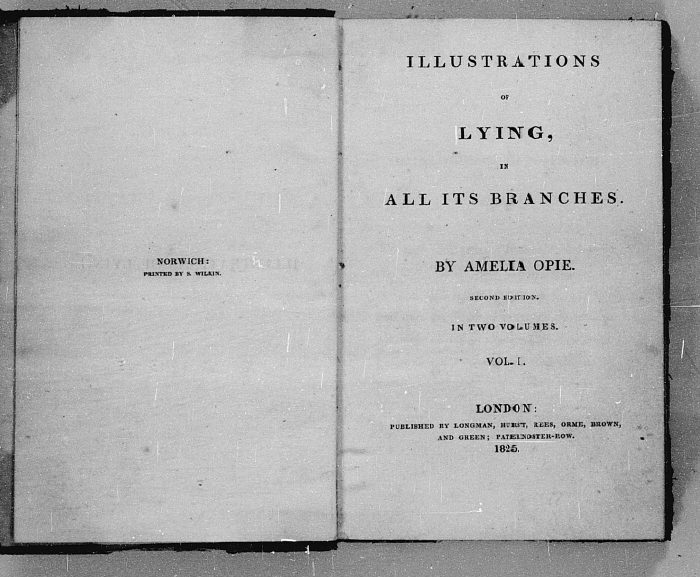Stories Before 1850. 0189: Amelia Opie, Illustrations of Lying
| Author: |
Opie, Amelia |
| Title: |
Illustrations of Lying, in all its branches. By Amelia Opie. Second Edition. In two volumes. Volume 1 |
| Cat. Number: |
0189 |
| Date: |
1825 |
| 1st Edition: |
1825 |
| Pub. Place: |
London |
| Publisher: |
Longman, Hurst, Rees, Orme, Brown, and Green; Paternoster Row |
| Price: |
Unknown |
| Pages: |
1 vol., 298pp. |
| Size: |
15.5 x 9 cm |
| Illustrations: |
None |
| Note: |
Volume 2 missing |
Images of all pages of this book

Introductory essay
Amelia Alderson, later Opie (1769-1853) was brought up in Norwich where her father was an eminent and popular physician. Like her father, Opie was a Unitarian, and she exhibited the same interests in literature and radical politics. When she visited London in 1794 she attracted the esteem, and either friendship or admiration, of other Unitarians, writers and radicals such as William Godwin, Anna Laetitia Barbauld, John Aikin, Mary Wollstonecraft and Thomas Holcroft. In 1797 she met John Opie, a painter, and they were married a year later. One novel, The Dangers of Coquetry, she had published already, and several other novels and poems followed rapidly, including The Father and Daugther (1801), the anti-Jacobin novel, Adeline Mowbray (1804), and Simple Tales (1806). John Opie died in 1807, and Amelia returned to Norwich where she lived with her father. She continued to publish collections of fiction - Tales of Real Life (1815), New Tales (1818) and Tales of the Heart (1820) - which both contemporary and modern critics have generally regarded as very mixed in quality. From 1814 onwards, Opie was attending Quaker services, and she finally joined the Society of Friends in 1825. This was either symptomatic or productive of a new piety in life which filtered through into her writing. By the 1820s she was contributing to periodicals such as The Amulet, or, Christian and Literary Remembrancer. Illustrations of Lying, which first appeared in 1825, was similarly religious in intention. This shift in Opie's output, from entertaining and sometimes ideologically-motivated fiction, to more pious work has resulted in critics characterising Opie has 'an artist who had thrown away a promising career to become a writer of religious tracts' (Simmons 1996: 264).
Simmons, James R., Jr., 'Amelia Opie', pp.261-64 in Dictionary of Literary Biography, 159: 'British Short Fiction Writers, 1800-1860', ed. John R. Greenfield, Detroit, MI: Gale Research Inc., 1996



